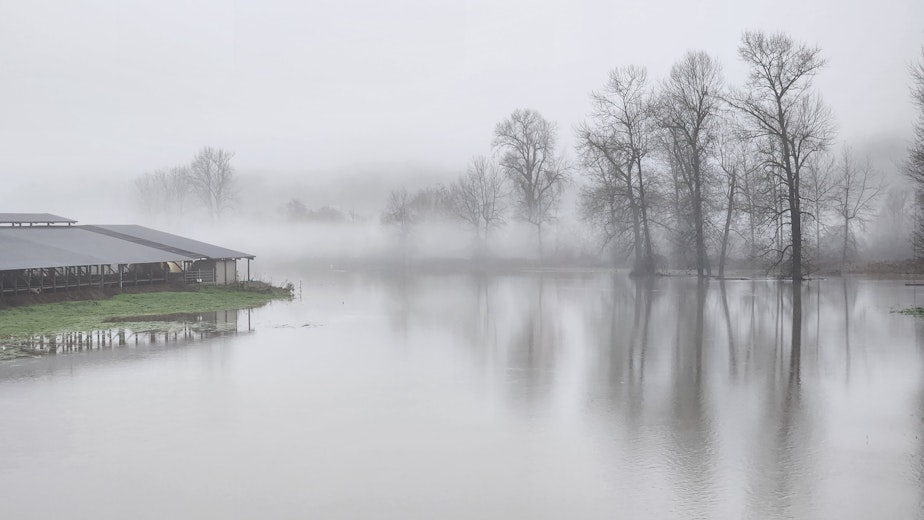Salmon, rivers hit hard by recent Washington floods

The atmospheric river that hit the Pacific Northwest in early December took a heavy toll on salmon, biologists working with Puget Sound tribes say.
You might think all the rain that comes with the storm systems known as atmospheric rivers or Pineapple Expresses would be good for fish.
But tribal biologists say major floods have hit salmon-bearing rivers hard two out of the past three autumns, at a time when freshly laid Chinook salmon eggs are incubating in their underwater nests.
“We've had two flooding events that, over three years, have hit during this time that we know all the Chinook eggs are in the gravels,” said fisheries researcher Mike LeMoine with the Skagit River System Cooperative, a project of the Swinomish and Sauk-Suiattle Tribes. “It's right after Chinook complete their spawning.”
Extreme flows can kill salmon eggs in two ways: scouring eggs and their shallow nests out of a riverbed or entombing them in mud.
“A big event will deposit a bunch of sediment over the top of the eggs and smother them, and they call that entombment,” said Jason Griffith, a Stillaguamish Tribe of Indians biologist.
Sponsored
Griffith said a spawning salmon will bury her eggs beneath a few inches of river gravel, enough to protect the next generation from predators but not from the forces unleashed when rivers rage.
“The river will cut down several inches to several feet during one event and could displace those eggs, and that kills them,” Griffith said.
Based on studies of past years’ floods, Griffith said he expected only 2% to 4% of Chinook eggs in the Stillaguamish River to survive this winter, less than a third of the 15% survival rate in a good year.
“High flows basically cause poor survival, especially for Stillaguamish Chinook. So three to five years from now, we will see lower returns of Stillaguamish Chinook,” Griffith said.

Sponsored
Atmospheric rivers and winter floods are a natural occurrence in the Pacific Northwest, though climate scientists expect their intensity to increase as the global climate keeps heating up.
Where they dump their heaviest precipitation, and how much, varies from storm to storm.
“We got hit by the firehose two years ago, where southern basins like Stillaguamish got hit more this year,” said LeMoine of the Skagit River cooperative.
The Stillaguamish River near Arlington hit all-time record levels on Dec. 5.
In November 2021, an atmospheric river dumped its heaviest rains onto the Skagit, Nooksack, and Canada’s Fraser River valleys, wreaking havoc on humans and fish there.
Sponsored
READ: Northern Washington tribes fear ‘devastation’ of salmon by extreme floodwaters
By the spring of 2022, fewer young Chinook salmon emerged from the Skagit River, by far, than any year on record, according to LeMoine.
The Skagit River produces the most salmon of any river on Puget Sound.
To the north, 2021 was a dismal year for producing young salmon on the Nooksack River as well, with lethal summer heat followed by extreme flooding in the fall.
In the spring of 2022, some of the lowest numbers of wild salmon on record emerged from the Nooksack River, according to Devin Flawd with the Lummi Nation Natural Resources Department.
Sponsored
“We simply did not see as many salmonids, especially wild Chinook, compared to previous years,” Flawd said in an email.
The chaos that a big flood unleashes on a river can also bring some long-term benefit to salmon: In destroying some habitats, it creates others.
“It cleans the canvas, if you will, and establishes new bends, new pool habitat, new riffles, and areas in which Chinook can rear,” LeMoine said.
“We did see new habitats formed, and we're actually very excited about that. However, the impact at the time was actually pretty pronounced,” he said.
To limit the impacts of flooding on people and salmon, the Stillaguamish and other tribes have been buying land and removing levees and buildings from flood-prone areas. With no obstacles in the way, high-energy floodwaters can spread out and leave young fish more refuges from flooding.
Sponsored
READ: Quinault Tribe builds new village site away from rising seas
“By setting infrastructure back and allowing the river more space to move, we can protect life and property, and we can restore salmon populations,” Griffith said.
Griffith said the direct impact of December flooding on the Stillaguamish Tribe was limited, since most tribal members and buildings moved out of the floodplain long ago.
“The tribe has been living with these floods for, you know, centuries, millennia, and in general, they would have their winter quarters up out of harm's way,” Griffith said.
After enduring major floods in 2003, 2006, 2009, and 2010, the Stillaguamish Tribe moved its natural resources building, where Griffith works, out of the Stillaguamish River floodplain in 2015.
“We really got tired of moving our computers up onto our desks and that sort of thing — and squeegeeing out the floors afterwards,” Griffith said.
The tribe demolished the old building and planted trees where it once stood.
Now, every time the river floods, Griffith said he’s grateful to be sitting above the fray.




